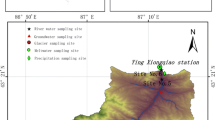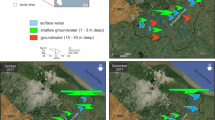Abstract
The Ballenera Creek has 160 km2 being a small catchment in the Pampa Plain in Argentina. This area has been deeply modified by human action through agricultural activities. From 2013 to 2017, electrical conductivity, stable isotopes of water and nitrate concentration monitoring program were conducted. The sampling included weekly and bimonthly samples in two sites along the stream, several groundwater wells and monthly precipitation. Chemical and isotopic tracers are used to discriminate the streamflow components and to evaluate their incidence in the nitrate concentration. The easiest conceptual model for gaining streams contemplates two main elements: direct runoff and groundwater (baseflow and pre-event water). The direct runoff has the lowest electrical conductivity and 18Ow variable content. The baseflow component is characterized by the highest electrical conductivity and isotope composition quite constant. Finally, pre-event water has an intermediate electrical conductivity and isotopic content close to the rainfall-weighted average composition. The nitrate concentration obtained was in general related to the different stream stages and was a useful indicator to evaluate the fertilization in agricultural zones.










Similar content being viewed by others
References
APHA-AWWA-WPCF (1989) Standard methods for the examination of water and wastewater, 17th edn. American Public Health Association, Washington
Calvi C (2017) Identificación de la descarga de aguas subterráneas en arroyos del sudeste de la Provincia de Buenos Aires con trazadores químicos e isotópicos. Facultad de Ciencias Exactas y Naturales. Universidad de Buenos Aires. Ph.D. thesis
Calvi C, Dapeña C, Martinez D, Gutheim F (2014) Caracterización química e isotópica de la cuenca del arroyo La Ballenera, Partido General Alvarado, provincia de Buenos Aires. Datos preliminares. Venturini et al (Eds), Memorias del II Congreso de Hidrología de Llanuras, Santa Fe, Universidad Nacional del Litoral, 7_100. ISBN 978-987-692-039-1
Calvi C, Dapeña C, Massone H, Martinez D (2016a) Características morfométricas y morfodinámicas de una cuenca hidrográfica de llanura. Revista de Geología Aplicada a la Ingeniería y al Ambiente 37:38–45. ISSN 1851-7838
Calvi C, Martinez D, Dapeña C, Ghuteim F (2016b) Abundance and distribution of fluoride concentrations in groundwater: La Ballenera catchment, southeast of Buenos Aires Province, Argentina. Environ Earth Sci 75:534. https://doi.org/10.1007/s12665-015-4972-8
Chapman T (1999) A comparison of algorithms for stream flow recession and baseflow separation. Hydrol Process 13:701–714
Chebotarev II (1955) Metamorphism of natural waters in the crust of weathering. Geochim Cosmochim Acta 8:22–48
CHEM (Chacra Experimental Miramar) Ministerio de Asunto Agrarios de la Provincia de Buenos Aires—Argentina, 2013. http://www.chacramiramar.com.ar/. Accessed 08 Aug 16
Dapeña C, Varni M, Panarello HO, Ducos E, Weinzentel P, Usunoff E (2010). Composición isotópica de la precipitación de la Estación Azul, provincia de Buenos Aires. Red Nacional de Colectores Argentina. En Varni, Entraigas y Vives (ED). I Congreso Internacional de Hidrología de Llanuras, Libro de Actas 386–393. Azul, provincia de Buenos Aires. ISBN 978-987-543-393-9
Gonfiantini R (1978) Standards for stable isotope measurements in natural compounds. Nature 271:534–536
Gonzalez N (2005) Los ambientes hidrogeológicos de a provincia de Buenos Aires. En: R.E. de Barrio, R.O. Etcheverry, M.F. Cabalié y E. Llambías (ed) Geología y Recursos Minerales de la Provincia de Buenos Aires. XXVI Congreso Geológico Argentino, Relatorio: 348–359. La Plata
Hewlett JD, Hibbert AR (1965) Factors affecting the response of small watersheds to precipitation in humid areas. In: Sopper WE, Lull HW (eds) Forest hydrology. Pergamon, Oxford, pp 275–290
Huarte MA, Capezio SB (2013) Cultivo de papa. Asignatura cultivo de papa. Unidad Integrada Balcarce Inta FCA UNMdP. http://inta.gob.ar/documentos/cultivo-depapa/at_multi_download/file/INTA-%20huarte_capezio_papa2013.pdf
Kendall C, McDonnell JJ (1998) Isotope tracers in catchment hydrology. Elsevier, Amsterdam, p 839
Kirchner JW (2003) A double paradox in catchment hydrology and geochemistry. Hydrol Process 17:871–874. Published online in Wiley InterScience www.interscience.wiley.com. https://doi.org/10.1002/hyp.5108
Klaus J, McDonnell JJ (2013) Hydrograph separation using stable isotopes: review and evaluation. J Hydrol 505:47–64
Kruse EE (1986) Aspectos geohidrológicos de la región sudoriental de Tandilla. Cuencas de los Aos. Vivoratá, Las Brusquitas y El Durazno. Asociación Geológica Argentina, Revista XLI (3–4):367–374
Lis G, Wassenaar LI, Hendry MJ (2008) High-precision laser spectroscopy D/H and 18O/16O measurements of microliter natural water samples. Anal Chem 80:287–293
Maloszewski P, Zuber A (1996) LP models for the interpretation of environmental tracer data. In: Manual on mathematical models in isotope hydrology. IAEA-TECDOC-910, Vienna, Austria, pp 9–58
Martinez, DE, Dapeña C, Massone H, Panarello HO, Quiroz Londoño OM, Ferrante A (2006) Hidrogeoquímica e Hidrología Isotópica aplicada al estudio de la relación agua subterránea- agua superficial en grandes cuencas: La cuenca del Río Quequén Grande, Buenos Aires, Argentina. VIII Congreso Latinoamericano de Hidrología Subterránea. Septiembre. Asunción, Paraguay
Martínez DE, Bocanegra EM (2002) Hydrochemistry and cationic exchange processes in the coastal aquifer of Mar del Plata, Argentina. Hydrogeol J 10(3):393–408
Martinez DE, Salomon K, Quiroz Londoño OM, Dapeña C, Massone HE, Benavente MA, Panarello H, Grondona S (2010) Tiempo medio de residencia del flujo base en aguas superficiales de la llanura pampeana: aplicación de isótopos del agua, gases nobles y CFCs en el río Quequpen Grande. En Varni, Entraigas y Vives (ed) I Congreso Internacional de Hidrología de Llanuras, Libro de Actas 420-427. Azul, provincia de Buenos Aires. ISBN 978-987-543-393-9
Martinez DE, Moschione E, Bocanegra E, Glok Galli M, Aravena R (2014) Distribution and origin of nitrate in groundwater in an urban and suburban aquifer in Mar del Plata, Argentina. Environ Earth Sci 72(6):1877–1886
Martinez DE, Quiroz Londoño OM, Salomon K, Dapeña C, Massone HE, Benavente MA, Panarello H (2017) Hydrogeochemistry, Isotopic composition and Water age in the hydrologic system of a large catchment within a plain humid environment (Argentine Pampa): Quequén Grande river, Argentina. River Res Appl 33:438–449
Martínez DE, Quiroz Londoño OM, Dapeña C, Massone HE, Ferrante A, Glok-Galli M, (2011) Caracterización Isotópica e Hidroquímica de las precipitaciones en el sector sur de Tandilia. VII Congreso Argentino de Hidrogeología Salta. Trabajo T47: 369–377. ISBN 978-987-23936-7-0
Sala JM (1975) Recursos Hídricos. Relatorio VI Congreso Geológico Argentino. Bahía Blanca, Argentina, pp 169–194
Sala JM, González N, Kruse EE (1983) Generalización Hidrológica de la Provincia de Buenos Aires. In: Coloquio sobre Hidrología de Grandes Llanuras. Vol II. PHI—UNESCO, Olavarría, pp 973–1009
Seiler KP, Lindner W (1995) Near-surface and deep groundwaters. J Hydrol 165:33–44
Stauffer RE (1985) Use of solute tracers released by weathering to estimate groundwater inflow to seepage lakes. Environ Sci Technol 19:405–411
Thornthwaite CW (1948) An approach towards a rational classification of climate. Geograph Rev 38:55–94
Vitvar T, Burns DA, Lawrence GW, Mcdonnell JJ, Wolock DM (2002) Estimation of baseflow residence times in watershed from the runoff hydrograph recession: method and application in the Neversink watershed, Catskill Mountains, New York. Hydrol Process 16:1871–1877
WHO World Health Organization (2004) Guidelines for drinkingwater quality, vol 1, 3rd edn. Geneva, Switzerland. ISBN 92 4154638 7
Winter TC (1999) Relation of streams, lakes, and wetlands to groundwater flow systems. Hydrogeol J 7:28–45
Acknowledgements
This study was economic support by grants from INGEIS and FONCyT (PICT-2014-1529). The authors are grateful to Mr. Eduardo Llambías (INGEIS, CONICET-UBA) forhis assistance in logistics and fieldwork, Mr. Gustavo Bernava, staff Laboratory of the Institute of Marine and Coastal Research (CONICET-UNMPD) for the water chemical analyses, Florencia Gutheim PhD and Mr. Oscar Urruty of Chacra Experimental Miramar for their invaluable cooperation.
Author information
Authors and Affiliations
Corresponding author
Additional information
This article is a part of Topical Collection in Environmental Earth Sciences on IV RAGSU—Advances in Geochemistry of the Surface in Argentina, edited by Dr. Americo Iadran Torres and Dr. Pablo Jose Bouza.
Rights and permissions
About this article
Cite this article
Calvi, C., Dapeña, C., Martinez, D.E. et al. Relationship between electrical conductivity, 18O of water and NO3 content in different streamflow stages. Environ Earth Sci 77, 248 (2018). https://doi.org/10.1007/s12665-018-7427-1
Received:
Accepted:
Published:
DOI: https://doi.org/10.1007/s12665-018-7427-1




